Abstract
In four patients with Pseudomonas aeruginosa infections, the infecting strain developed resistance to moxalactam during therapy with this drug. In addition, P. aeruginosa isolates from two of these four patients showed increased resistance to aminoglycosides. Isolates from a third patient acquired cross-resistance to other antipseudomonal beta-lactams. In three of the cases, disk susceptibility tests failed to detect the resistance that was demonstrated in broth dilution assays. Isolate identities were confirmed by serotyping. No new plasmids were found by agarose gel electrophoresis. The mechanisms for this resistance did not involve enzymatic antibiotic degradation. These findings suggest that currently available expanded-spectrum cephalosporin derivatives should probably not be used alone for most serious infections due to P. aeruginosa. They also suggest that strains with multiple antibiotic resistance may become more prevalent in hospitals if these drugs are used extensively.
Full text
PDF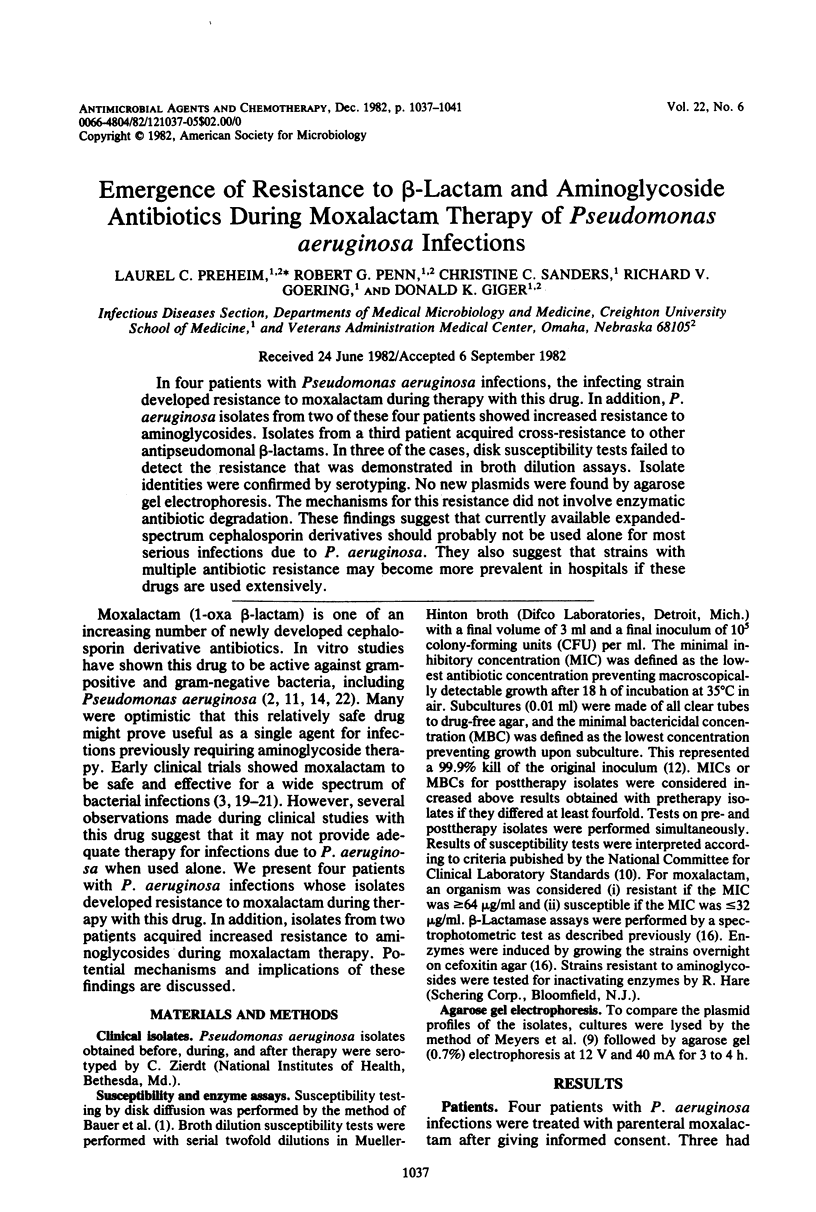
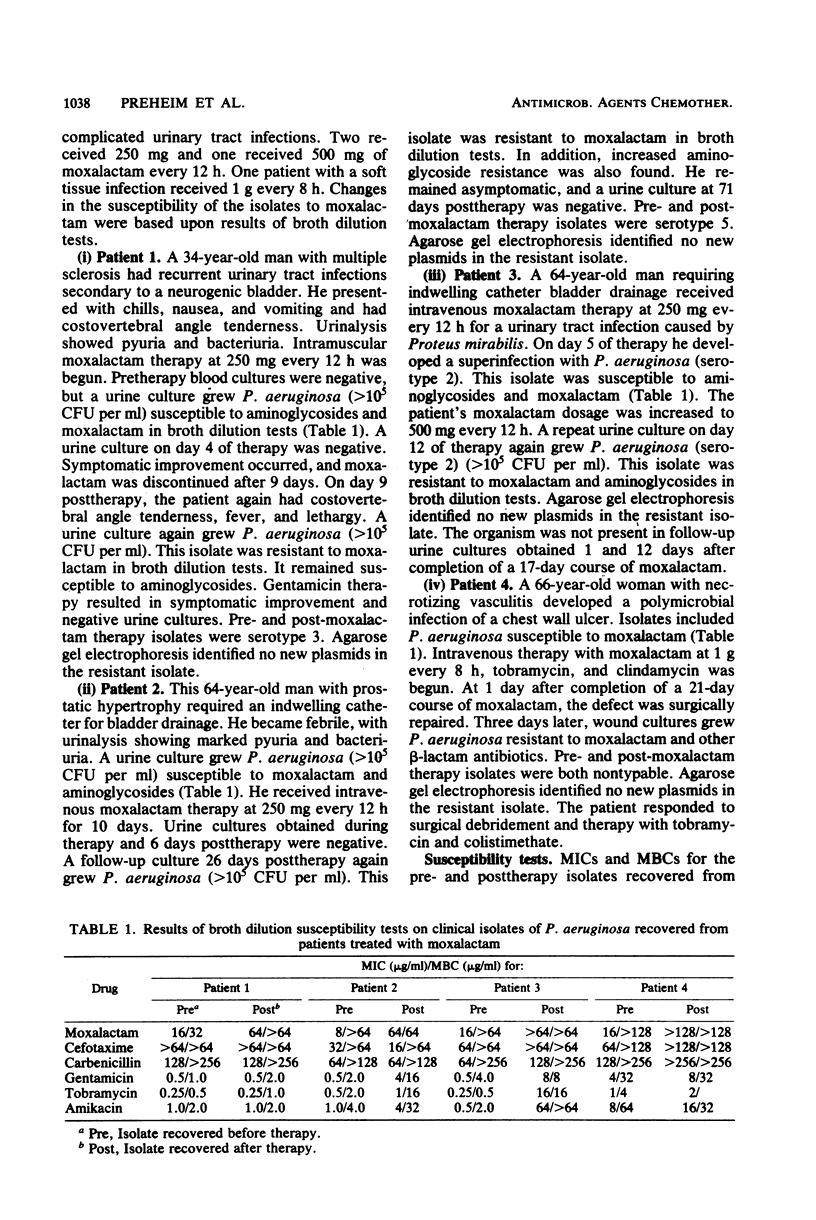
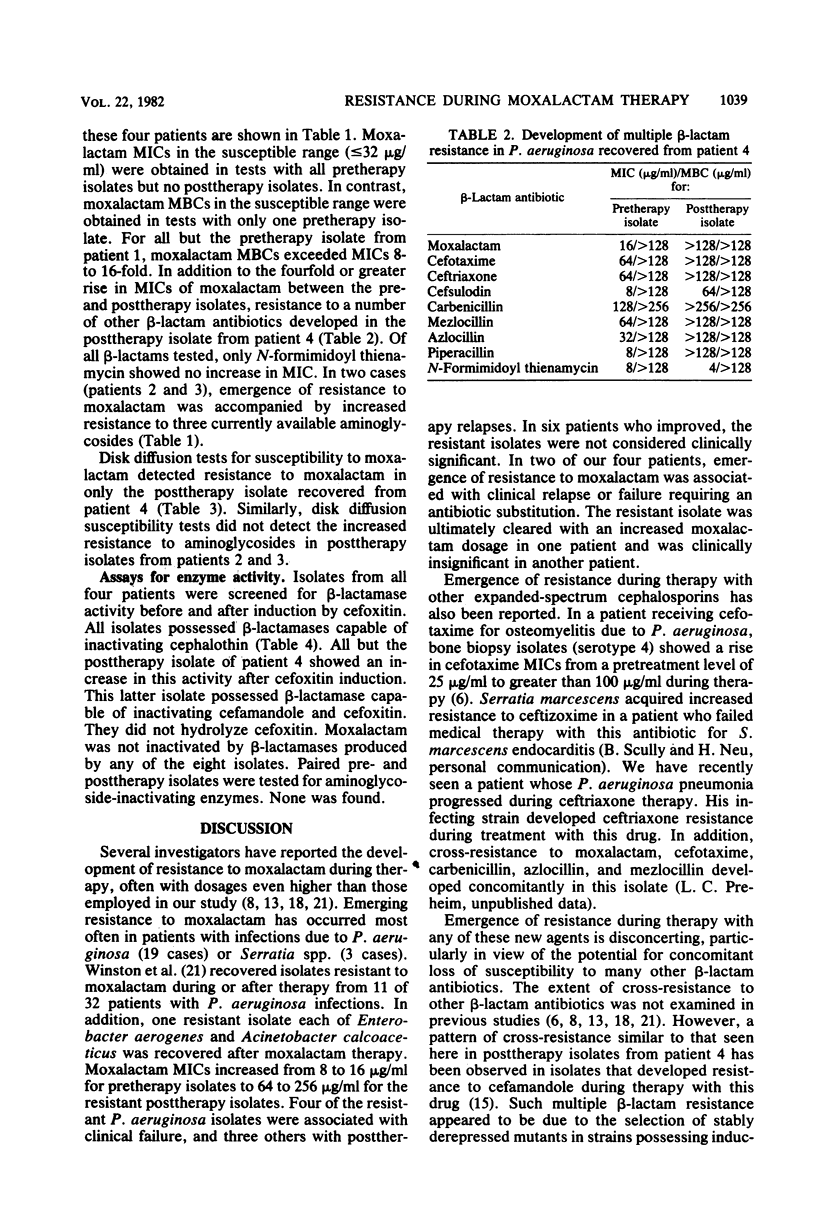
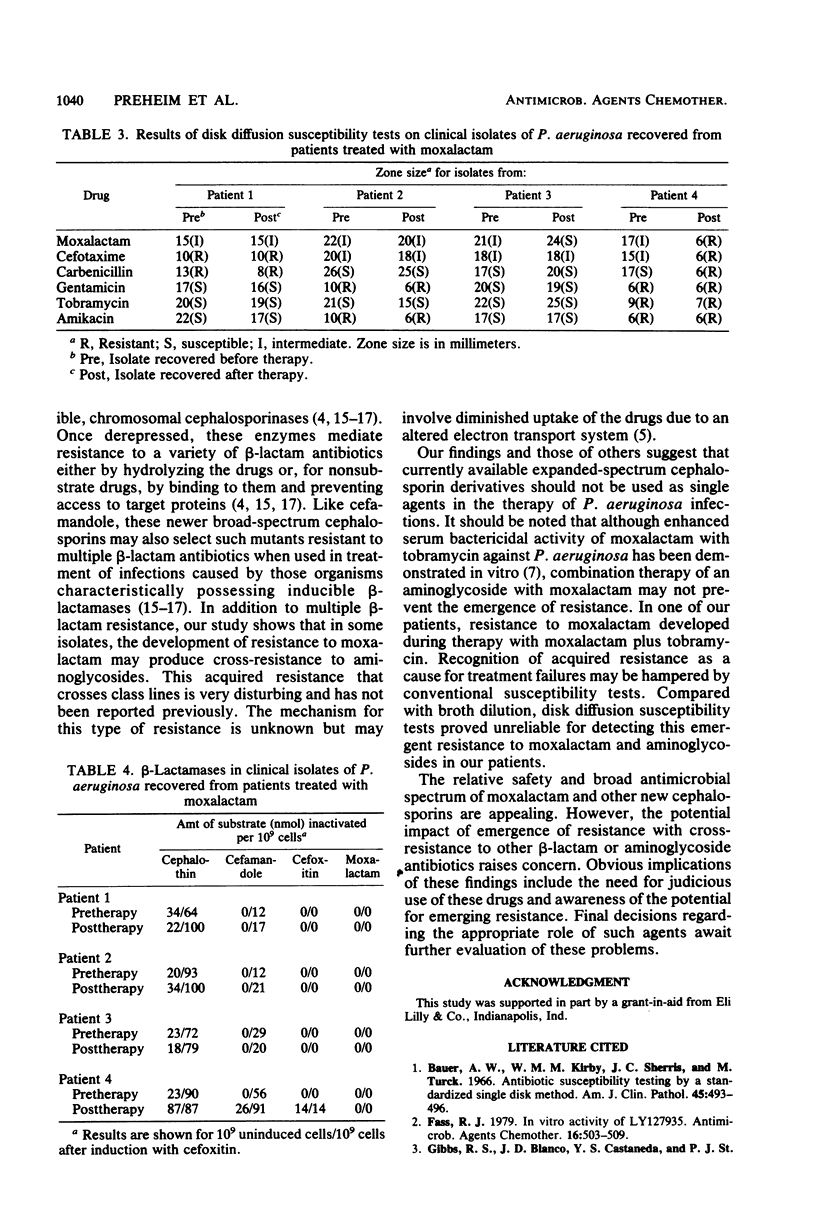
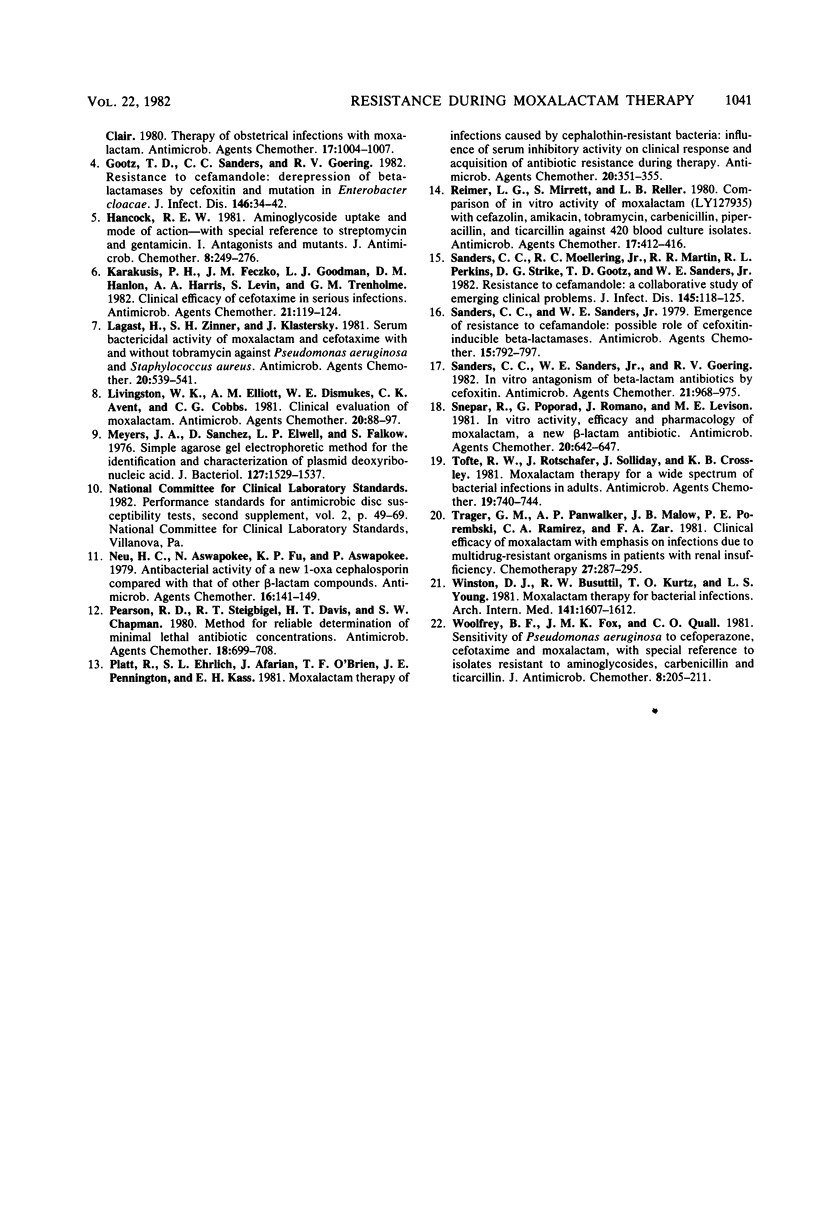
Selected References
These references are in PubMed. This may not be the complete list of references from this article.
- Bauer A. W., Kirby W. M., Sherris J. C., Turck M. Antibiotic susceptibility testing by a standardized single disk method. Am J Clin Pathol. 1966 Apr;45(4):493–496. [PubMed] [Google Scholar]
- Fass R. J. In vitro activity of LY127935. Antimicrob Agents Chemother. 1979 Oct;16(4):503–509. doi: 10.1128/aac.16.4.503. [DOI] [PMC free article] [PubMed] [Google Scholar]
- Gibbs R. S., Blanco J. D., Castaneda Y. S., St Clair P. J. Therapy of obstetrical infections with moxalactam. Antimicrob Agents Chemother. 1980 Jun;17(6):1004–1007. doi: 10.1128/aac.17.6.1004. [DOI] [PMC free article] [PubMed] [Google Scholar]
- Gootz T. D., Sanders C. C., Goering R. V. Resistance to cefamandole: derepression of beta-lactamases by cefoxitin and mutation in Enterobacter cloacae. J Infect Dis. 1982 Jul;146(1):34–42. doi: 10.1093/infdis/146.1.34. [DOI] [PubMed] [Google Scholar]
- Hancock R. E. Aminoglycoside uptake and mode of action--with special reference to streptomycin and gentamicin. I. Antagonists and mutants. J Antimicrob Chemother. 1981 Oct;8(4):249–276. doi: 10.1093/jac/8.4.249. [DOI] [PubMed] [Google Scholar]
- Karakusis P. H., Feczko J. M., Goodman L. J., Hanlon D. M., Harris A. A., Levin S., Trenholme G. M. Clinical efficacy of cefotaxime in serious infections. Antimicrob Agents Chemother. 1982 Jan;21(1):119–124. doi: 10.1128/aac.21.1.119. [DOI] [PMC free article] [PubMed] [Google Scholar]
- Lagast H., Zinner S. H., Klastersky J. Serum bactericidal activity of moxalactam and cefotaxime with and without tobramycin against Pseudomonas aeruginosa and Staphylococcus aureus. Antimicrob Agents Chemother. 1981 Oct;20(4):539–541. doi: 10.1128/aac.20.4.539. [DOI] [PMC free article] [PubMed] [Google Scholar]
- Livingston W. K., Elliott A. M., Dismukes W. E., Avent C. K., Cobbs C. G. Clinical evaluation of moxalactam. Antimicrob Agents Chemother. 1981 Jul;20(1):88–97. doi: 10.1128/aac.20.1.88. [DOI] [PMC free article] [PubMed] [Google Scholar]
- Meyers J. A., Sanchez D., Elwell L. P., Falkow S. Simple agarose gel electrophoretic method for the identification and characterization of plasmid deoxyribonucleic acid. J Bacteriol. 1976 Sep;127(3):1529–1537. doi: 10.1128/jb.127.3.1529-1537.1976. [DOI] [PMC free article] [PubMed] [Google Scholar]
- Neu H. C., Aswapokee N., Fu K. P., Aswapokee P. Antibacterial activity of a new 1-oxa cephalosporin compared with that of other beta-lactam compounds. Antimicrob Agents Chemother. 1979 Aug;16(2):141–149. doi: 10.1128/aac.16.2.141. [DOI] [PMC free article] [PubMed] [Google Scholar]
- Pearson R. D., Steigbigel R. T., Davis H. T., Chapman S. W. Method of reliable determination of minimal lethal antibiotic concentrations. Antimicrob Agents Chemother. 1980 Nov;18(5):699–708. doi: 10.1128/aac.18.5.699. [DOI] [PMC free article] [PubMed] [Google Scholar]
- Platt R., Ehrlich S. L., Afarian J., O'Brien T. F., Pennington J. E., Kass E. H. Moxalactam therapy of infections caused by cephalothin-resistant bacteria: influence of serum inhibitory activity on clinical response and acquisition of antibiotic resistance during therapy. Antimicrob Agents Chemother. 1981 Sep;20(3):351–355. doi: 10.1128/aac.20.3.351. [DOI] [PMC free article] [PubMed] [Google Scholar]
- Reimer L. G., Mirrett S., Reller L. B. Comparison of in vitro activity of moxalactam (LY127935) with cefazolin, amikacin, tobramycin, carbenicillin, piperacillin, and ticarcillin against 420 blood culture isolates. Antimicrob Agents Chemother. 1980 Mar;17(3):412–416. doi: 10.1128/aac.17.3.412. [DOI] [PMC free article] [PubMed] [Google Scholar]
- Sanders C. C., Moellering R. C., Jr, Martin R. R., Perkins R. L., Strike D. G., Gootz T. D., Sanders W. E., Jr Resistance to cefamandole: a collaborative study of emerging clinical problems. J Infect Dis. 1982 Jan;145(1):118–125. doi: 10.1093/infdis/145.1.118. [DOI] [PubMed] [Google Scholar]
- Sanders C. C., Sanders W. E., Jr Emergence of resistance to cefamandole: possible role of cefoxitin-inducible beta-lactamases. Antimicrob Agents Chemother. 1979 Jun;15(6):792–797. doi: 10.1128/aac.15.6.792. [DOI] [PMC free article] [PubMed] [Google Scholar]
- Sanders C. C., Sanders W. E., Jr, Goering R. V. In vitro antagonism of beta-lactam antibiotics by cefoxitin. Antimicrob Agents Chemother. 1982 Jun;21(6):968–975. doi: 10.1128/aac.21.6.968. [DOI] [PMC free article] [PubMed] [Google Scholar]
- Snepar R., Poporad G., Romano J., Levison M. E. In vitro activity, efficacy, and pharmacology of moxalactam, a new beta-lactam antibiotic. Antimicrob Agents Chemother. 1981 Nov;20(5):642–647. doi: 10.1128/aac.20.5.642. [DOI] [PMC free article] [PubMed] [Google Scholar]
- Tofte R. W., Rotschafer J., Solliday J., Crossley K. B. Moxalactam therapy for a wide spectrum of bacterial infections in adults. Antimicrob Agents Chemother. 1981 May;19(5):740–744. doi: 10.1128/aac.19.5.740. [DOI] [PMC free article] [PubMed] [Google Scholar]
- Trager G. M., Panwalker A. P., Malow J. B., Porembski P. E., Ramirez C. A., Zar F. A. Clinical efficacy of moxalactam with emphasis on infections due to multidrug-resistant organisms in patients with renal insufficiency. Chemotherapy. 1981;27(4):287–295. doi: 10.1159/000237993. [DOI] [PubMed] [Google Scholar]
- Winston D. J., Busuttil R. W., Kurtz T. O., Young L. S. Moxalactam therapy for bacterial infections. Arch Intern Med. 1981 Nov;141(12):1607–1612. [PubMed] [Google Scholar]
- Woolfrey B. F., Fox J. M., Quall C. O. Susceptibility of Pseudomonas aeruginosa to cefoperazone, cefotaxime and moxalactam, with special reference to isolates resistant to aminoglycosides, carbenicillin and ticarcillin. J Antimicrob Chemother. 1981 Sep;8(3):205–211. doi: 10.1093/jac/8.3.205. [DOI] [PubMed] [Google Scholar]


